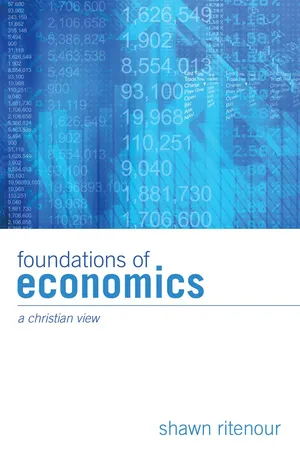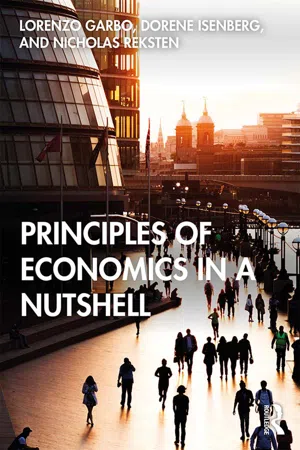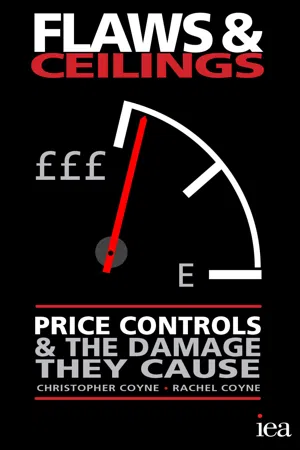Economics
Price Ceilings
Price ceilings are government-imposed maximum prices that can be charged for goods and services. They are designed to protect consumers by keeping prices affordable, particularly for essential items. However, price ceilings can lead to shortages and reduce the incentive for producers to supply the goods or services in question.
Written by Perlego with AI-assistance
Related key terms
7 Key excerpts on "Price Ceilings"
- eBook - ePub
Foundations of Economics
A Christian View
- Ritenour(Author)
- 2010(Publication Date)
- Wipf and Stock(Publisher)
15 Price Controls I n the previous two chapters we introduced detailed analysis of one facet of government intervention in the economy. We analyzed the nature and consequences of interventionist macroeconomic policy and discovered that neither monetary inflation nor government spending are efficient ways to expand an economy. Macroeconomic policy, however, is only one category of state intervention in the economy. Another common form of intervention is price controls. Price controls are the result of laws regulating prices at which people can legally buy and sell. Rarely do governments force buyers and sellers to accept a single price to make an exchange. Instead governments prefer to set maximum and minimum prices. Price Ceilings The form of price control governments often use in an attempt to thwart the negative consequences of monetary inflation is the price ceiling. As the name implies, a price ceiling is a maximum legal price. If you attempt to throw this textbook up into the air as far as it will go, what will stop it? What is the barrier above which it cannot fly? The ceiling. Just as the ceiling in an indoor room is the highest a thrown object can travel, a price ceiling is the highest price that buyers can legally pay and that sellers can legally accept. There are two types of Price Ceilings: effective and ineffective. We will initially investigate the consequences of an effective price ceiling, but first need to understand what we mean by the words effective and ineffective. Typically, those words are taken to mean that something either works well or does not. In our case, however, the terms refer to whether the price ceiling has an effect on the actual price that buyers pay and sellers receive in an exchange. An effective price ceiling hampers voluntary exchange from negotiating a market price - eBook - ePub
- Lorenzo Garbo, Dorene Isenberg, Nicholas Reksten(Authors)
- 2020(Publication Date)
- Routledge(Publisher)
Controls can stipulate a price ceiling, i.e. a maximum price, at which a good/service can be legally bought and sold, or a price floor, i.e. a minimum price at which a good/service can be legally bought and sold. A good example of a price ceiling is given by the controls on electricity prices in Venezuela, where prices have been kept low in order to help the poor have access to electricity. A good example of a price floor in the US is the price of sugar, which by law cannot fall below a certain level. A price ceiling, seen in Figure 3.14, is effective only in situations of excess demand of a good, as those are the only situations in which the price would tend to increase. Thus, a price ceiling somehow locks a market in a situation of excess demand. Is this a good thing? Yes and no … on one side, some consumers will be able to obtain the good at an affordable price. On the other, persistent shortages can lead to the development of black markets, illegal, parallel markets where the good is exchanged at the actual market price. Persistent shortages are also often accompanied by long lines at the stores, as consumers hope to be “among the first ones” to obtain the limited amount of the good. Finally, Price Ceilings are often responsible for a deterioration of the quality of the good: this is the effect that the Venezuelan price ceiling has had, as the utility invested in fewer power plants, leading to widespread blackouts. FIGURE 3.14 Graphical representation of an effective price ceiling A price floor, represented in Figure 3.15, is effective only in situations of excess supply of a good, as those are the only situations in which the price would tend to decrease. Thus, a price floor locks a market in a situation of excess supply. Again, is this a good thing? Price floors are used both in the US and in the European Union to sustain agricultural prices – and so farmers’ income - eBook - ePub
Flaws and Ceilings
Price Controls and the Damage They Cause
- Christopher Coyne, Rachel Coyne, Philip Booth, Ryan Bourne, Stephen Davies, Robert Miller, Colin Robinson, Steven Schwartz, W. Stanley Siebert, Christopher Snowdon, Richard Wellings(Authors)
- 2015(Publication Date)
- London Publishing Partnership(Publisher)
8. Price Ceilings in financial markets
Philip Booth and Stephen DaviesControls and ceilings on the quantity and cost of credit are probably the oldest form of price control. They are also among the most damaging. Often, as in the Islamic world or classical Greece, the very idea of lending money with interest attached is condemned as unnatural or impious. This was also, of course, the position of early Christians. However, so great is the need for credit in any functioning economy beyond subsistence level that, in practice, lending at interest still happens no matter what the theologians and philosophers may argue. What tends to happen, as with the medieval anti-usury laws, is that a ban on ‘excessive’ interest substitutes for a ban on all interest. In other words, there is a ceiling set on the level of interest that may be charged for a loan. This is quite simply a price cap and, like all such caps, it has economically damaging and disruptive effects.Moreover, because of the central role of money in exchange and in economic activity in general, and given the central place of credit in facilitating growth and innovation, Price Ceilings on credit have impacts that are more extensive and harmful than those imposed on other aspects of economic life. In particular, because for every debtor there is also a creditor, interest rate caps have far reaching impacts on investment returns in general. As well as being a limit on charges to borrowers, they necessarily limit returns to certain kinds of investment and, indirectly, some or most kinds of savings.The most common form of interest ceiling is a cap on the level or amount of interest that can be charged to a borrower. Sometimes, limitations of this kind are imposed in general, on all kinds of loans and credit and on all borrowers, as for example during the Middle Ages in Europe (at least in theory). More often, caps are imposed on specific kinds of loan or credit. In these cases the restrictions are typically applied to credit products that are disproportionately used – or thought to be used – by people on low or irregular incomes. The usual goal of a ceiling on interest is to protect borrowers on low incomes from the consequences of their own lack of financial literacy (i.e. an information asymmetry). However, this intention is usually portrayed as being a matter of protecting low-income borrowers against so-called ‘predatory’ lenders. - eBook - ePub
- Neva Goodwin, Jonathan M. Harris, Julie A. Nelson, Pratistha Joshi Rajkarnikar, Brian Roach, Mariano Torras(Authors)
- 2022(Publication Date)
- Routledge(Publisher)
But in other cases, especially where the elasticity of supply is high, price controls can be disastrous. One example is in Zimbabwe, where extensive price controls were imposed in 2007 with the goal of keeping prices for food and other essential goods low. As our example leads us to expect, the result of enforced low prices was to destroy the incentive for farmers and other suppliers to produce, leading to severe shortages. So, the poor people whom the policy was supposed to help were instead hurt by the unavailability of food and other basic goods. Meanwhile, farmers and other merchants were forced into bankruptcy. The price controls had to be abandoned after they forced the economy into virtual collapse.4.3 Price Floors
Governments also sometimes intervene in markets with the opposite goal—to keep prices from falling to the market equilibrium. A price set above the market price is called a price floor or “price support” (because it establishes a minimum allowable price).price floor: a regulation that specifies a minimum price for a particular productWhy would governments want to keep prices at higher levels? The obvious reason is to aid producers. Governments commonly specify minimum prices for agricultural products such as grain or milk. The goal is to help farmers, who often have considerable political influence. Of course, this also pushes up prices to consumers.The economic effect is the opposite of a price ceiling. Rather than creating a shortage, price floors tend to create a surplus, as producers increase their output to take advantage of profitable higher prices. But these higher prices cause consumers to cut back their purchases. In some cases, the government will buy up the surplus created by the price floor. From an economic point of view, this is clearly inefficient, because it encourages excess production and involves both higher prices to consumers and large government expenditures. Generally, economists would recommend a more efficient approach of giving direct aid to farmers, if this were considered necessary, but leaving market prices alone.Another classic example of a price floor is the minimum wage. Most governments have minimum wage laws specifying that hourly wages must be at least a given level. The United States has a federal minimum wage of $7.25 per hour (as of 2022), although about 30 states have set higher minimum wage rates. Most other developed countries have higher minimum wage rates. For example, the minimum wage is equivalent to about $10 per hour in Canada, about $11 per hour in France, and $15 per hour in Australia.6 - eBook - ePub
Power, Property Rights, and Economic Development
The Case of Bangladesh
- Mohammad Dulal Miah, Yasushi Suzuki(Authors)
- 2018(Publication Date)
- Palgrave Macmillan(Publisher)
© The Author(s) 2018Begin AbstractPower, Property Rights, and Economic Development https://doi.org/10.1007/978-981-13-2763-6_7Mohammad Dulal Miah andYasushi Suzuki7. Property Rights and Price Control
End AbstractMohammad Dulal Miah1andYasushi Suzuki2(1) University of Nizwa, Birkat Al Mawz, Oman(2) Ritsumeikan Asia Pacific University, Beppu, JapanMohammad Dulal Miah (Corresponding author)Yasushi Suzuki7.1 Introduction
The economic rationale of many government regulations can be derived by applying the property rights framework. Price control is one of such legislative actions that can be analyzed from a property rights perspective. Price control imposes restrictions on private contracting by fixing the price of economic resources for which market price is available. If the control price remains below the market clearing rate, the unassigned portion of the economic value (the difference between the market price and the control price) is left to the public domain . People spend resources to capture a portion of that unassigned value. Spending economic resources for already produced goods is equivalent to social waste. In contrast, government may set up prices for some goods or services which are more than the market clearing price. The difference between the market price and the fixed price in this particular regard is equivalent to tax , which increases the marginal cost to the producer, providing an ill incentive to reduce the production, possibly causing deadweight welfare loss.The call for price ceiling or price fixing for consumption goods is generally motivated by a belief that such ceiling makes consumers better off. For instance, it is argued that putting a cap on the price of competitive goods can ensure that the goods remain affordable to most citizens. Evans (1982 ) relates the logic of price control to inflation and argues that the general price control would be a great idea if inflation imposes social costs in the form of more expense in calculating and posting prices, social unrest, and uncertainty - eBook - ePub
Global Food Security
What Matters?
- Zhang-Yue Zhou(Author)
- 2019(Publication Date)
- Routledge(Publisher)
When governments intervene, very often some consumer surplus is transferred to become producer surplus, or part of the producer surplus is transferred to become consumer surplus. Such transfers are also often associated with losses of efficiency in the economy, i.e., the creation of DWLs.Some examples of policy tools used to intervene in the food market are examined below. We examine them for their impact on price and quantity, the extent to which economic surplus is transferred between consumers and producers, and the welfare losses to the country as a whole.9.3.1 Price ceiling
A price ceiling is a government-imposed price control, or limit, on the price charged for a product. If this ceiling is above the market equilibrium price, it is not binding – producers are more than happy to sell their product at a price higher than the equilibrium price. If it is below the equilibrium price, it is then binding and production is limited.When the price ceiling is set below the market equilibrium price, consumers find they now pay a lower price for the same product and subsequently they increase their purchases. In the meantime, producers find they are receiving a lower price than they were receiving before. They are not happy to produce as much as they used to. The combined effect is that there is now a supply shortage. This leads to surplus transfers and DWL.A binding price ceiling prevents the market from moving towards the equilibrium (Figure 9A.1 ). The impacts of a binding price ceiling include (how these impacts arise is explained in Appendix 9A ):- Reduced quantity of food supplied, but increased quantity demanded at the ceiling price, leading to a shortage.
- A transfer of surplus from producers to consumers, resulting in higher consumer surplus but reduced producer surplus.
- A deadweight loss.
Clearly, this policy tool is counterproductive in boosting a country’s food supply and does not help a country to balance its food demand and supply. Its adoption works against a country’s effort to improve food security. It is often used in low-income and food-insecure countries to lower prices for non-farming consumers at the expense of producers. In the long run, it generally also works against the interest of consumers when food supply shortages become persistent. - eBook - ePub
- STEVEN PRESSMAN(Author)
- 2013(Publication Date)
- Routledge(Publisher)
maxima for a number of particular prices … helps a government to hold back the ultimate threat of galloping inflation. … Government restriction of particular prices is not then a policy either foredoomed to failure or necessarily futile’ (Pigou, 1941, p. 118).1.2. What is meant by Price Controls‘Price controls’ does not necessarily mean government imposition of some precise price at which given commodities must be bought and sold. This is just one option among many. By ‘price controls’, authors like John Kenneth Galbraith meant a wide variety of policies by which market prices that are causing problems can be modified or influenced. Price controls are thus a palette of measures among which the policy maker can choose according to the particular problem he wishes to solve or alleviate. In some cases it will be a legal maximum on a given price (as proposed by Smith for the rate of interest), in others a legal minimum (as the minimum wage), sometimes a minimum price at which the government promises to buy and a maximum at which it promises to sell (as for certain agricultural commodities), sometimes a temporary price freeze, and sometimes a maximum or minimum for price changes. This is probably why the plural word ‘controls’ is often used.The fundamental idea behind price controls is that if the free movement of certain prices produces very bad consequences (as during a mobilization for war), or if it makes it impossible, or very difficult, to attain some important national goal (like full employment without inflation or access to food for everyone), it is legitimate to keep an eye on these prices and eventually do something that makes the situation better. Most economists agree on this point, but then many go on to exclude price controls from the policy options that are on the table. Not Galbraith (1951, p. 15), who believed that ‘we cannot exclude from use any weapon that is necessary … it would be reckless to decide in advance that price controls should not be used’.
Index pages curate the most relevant extracts from our library of academic textbooks. They’ve been created using an in-house natural language model (NLM), each adding context and meaning to key research topics.






